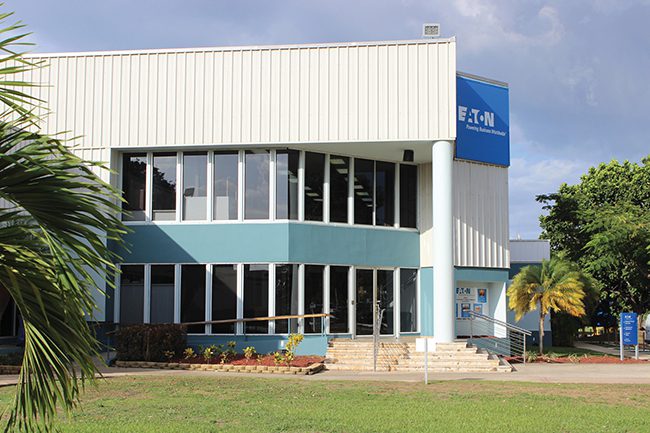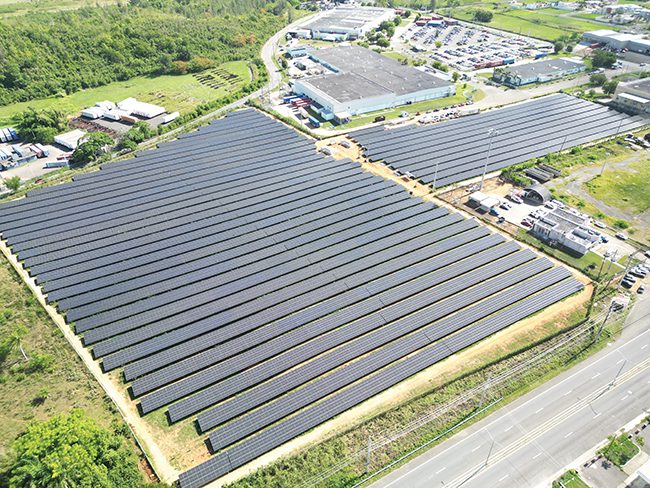Eaton Among Groups Supporting Microgrid Buildout in Puerto Rico
Companies operating in Puerto Rico have paid particular attention to the reliability and resiliency of their power supply after a series of major hurricanes battered the island in recent years. Those storms, which crippled energy infrastructure and left some areas without electricity for up to a year, brought calls for grid modernization and also have spurred U.S. government action to accelerate the pace of energy projects, including renewable energy installations.
 |
|
1. Eaton in April announced completion of a microgrid project to provide power for its manufacturing facility in Arecibo, Puerto Rico. Enel North America built, owns, and operates the system on behalf of Eaton. Courtesy: Eaton |
Eaton, a U.S.-based global power management group, in early April began operating a clean energy project at its Arecibo, Puerto Rico, manufacturing facility (Figure 1), a site where the company makes circuit breakers used in homes, buildings, and industrial applications. Eaton officials said the microgrid, deployed by Eaton along with Enel North America, substantially reduces the facility’s carbon footprint. It also boosts the manufacturing center’s energy resilience, and supports the surrounding energy infrastructure. Puerto Rican officials have said the microgrid provides a model for energy projects to support power reliability and resilience, and also the use of renewable energy resources on the island.
“Climate emergencies, power outages, and energy costs are soaring—underscoring the need for far more resilient and cost-efficient power for manufacturing,” said Rich Gorze, global energy manager at Eaton. At the same time, the global push for sustainability has intensified, driven by environmental, social, and governance (ESG) targets, net-zero goals, and a focus on environmental stewardship. Gorze told POWER, “Taking control of your onsite energy needs with a combination of renewables, energy storage, and microgrid systems provides a hedge against rising energy costs, power outages, or other sudden impact to local energy systems. Further, it provides a competitive advantage for businesses and communities by reducing costs and advancing sustainable, resilient energy systems.”
Government officials and those in the energy industry serving Puerto Rico began looking at microgrids as a way to support the island’s power grid after storms, including Hurricane Maria in 2017 and Hurricane Fiona in 2022, showed the need to overhaul power generation, transmission, and distribution in the region. Proposals have included establishing microgrids to provide reliable electricity in rural areas, and connecting a network of microgrids across the island to support grid infrastructure.
Mike Yelton, president, Americas Region, Electrical Sector at Eaton, said, “Communities and businesses everywhere need far more sustainable, resilient, and affordable power. The projects at our Arecibo manufacturing facility provide a blueprint on how to put the energy transition to work—delivering important benefits for the community and our business. Together, with our longtime project partner Enel North America, we’re demonstrating the important role microgrids play in creating a robust energy infrastructure prepared to address the impact from climate change.”
|
|
|
2. The microgrid system at Eaton’s manufacturing facility in Arecibo, Puerto Rico, includes 5 MW of solar power generation. Courtesy: Eaton |
The microgrid features Eaton’s “Everything as a Grid” approach, which enables flexible energy systems that support more resilient, efficient, and affordable power. The project will generate more than half of the manufacturing plant’s energy needs to help reduce emissions, offset energy costs, and ensure resilience during grid outage events. The microgrid includes 5 MW of solar power (Figure 2), about 1.1 MW of battery energy storage, and also utilizes existing onsite generators.
Said Gorze, “We’ve taken an ‘Everything as a Grid’ approach to the energy transition that reinvents the way power is distributed, stored, and consumed that increases and optimizes available energy by enabling new flexibility in energy infrastructure. And we’re putting this strategy to work in our own facilities to shore up our energy resilience, advance sustainability and energy affordability.”
Pedro Pierluisi, Puerto Rico’s governor whose administration is working with U.S. officials on energy projects, said, “In our administration, we continue to focus on Puerto Rico’s energy transformation that promotes increased renewable energy generation. I congratulate Eaton for continuing to invest in Puerto Rico and supporting this transformation with the building of a clean energy microgrid that will provide them with energy resiliency, while also reducing their carbon footprint. This is the type of project that we are working to see replicated throughout the island.”
Carlos Ramirez Irizarry, mayor of Arecibo, said, “With this project, Eaton is advancing its sustainable manufacturing operations in Arecibo and turns our municipality into one of the leaders on renewable energy in Puerto Rico.” The microgrid is designed to withstand Category 5 strength hurricane-force winds. Officials noted that it provides added value in normal grid-connected operations by generating renewable energy that can be consumed, stored, and delivered back to the local power grid, which can reduce stress on the island’s utility infrastructure. Eaton and Enel North America also are building a second microgrid at Eaton’s Las Piedras manufacturing facility as part of the groups’ strategy to support the island’s energy resilience.
Juan Saca, president and CEO of LUMA, the grid operator in Puerto Rico, said, “All of us at LUMA are committed to building a cleaner, more reliable and resilient electric grid. As Puerto Rico’s T&D [transmission and distribution] operator and having helped connect over 84,000 customers to net energy metering programs, we are proud to support customers like Eaton and Enel that are championing clean energy and energy efficiency, and look forward to many more industrial customers following their lead.”
Gorze told POWER that Eaton also is implementing energy efficiency measures at the Arecibo plant, which he said “reduced our energy use by 45%. Adding a solar-plus-storage microgrid is giving us greater control over our energy supplies and costs. Together, these measures are substantially boosting energy resilience, cutting our carbon footprint, and reducing our energy spend by nearly 20%. The microgrid system, in particular, provides a powerful approach to take control of our energy supplies and reduce our carbon footprint. This system balances where, when, and how electricity is consumed. It provides the control over our onsite energy sources—including the solar, storage, and existing onsite generators—and enables us to island from the grid, keeping the power on, for example, even when the grid is down.”
Matt Barnes, head of distributed energy solutions at Enel North America, said, “As the impacts of climate change worsen, large energy users are stepping up to power their facilities sustainably. Enel is proud to partner with Eaton in building a future for manufacturing that reaches beyond facility walls to support energy resiliency for the broader community. The urgency to deploy microgrids—especially in regions with vulnerable electrical infrastructure—has never been greater.” Enel North America built, owns, and operates the system on behalf of Eaton. Enel North America financed the project under an energy-as-a-service model, shifting Eaton’s investment in the microgrid system from a capital to an operational expense. Eaton provided installation expertise and key technologies for the microgrid system, including its Power Xpert microgrid solutions and leading power distribution equipment.
“In a world increasingly reliant on electricity and focused on sustainability, adopting a more intelligent approach to power manufacturing is crucial,” said Gorze. “Businesses must strategize to prepare their facilities for the evolving energy landscape. In my opinion, microgrids are an important tool to meet the moment and prepare for the future. These intelligent systems offer greater control over energy systems, unlocking opportunities for increased efficiency, resilience, and decarbonization while making the integration of DERs [distributed energy resources] simple and straightforward.”
—Darrell Proctor is a senior associate editor for POWER (@POWERmagazine).
